Nature Notes
by Bob Thomas
A walk down the beach where the water laps up on the sand, especially in Alabama and Florida where the water is clear and the sand is white, is relaxing but can be a bit biologically misleading.
From all appearances, there is no life at this interface between land and the sea. On the beach side, there are plenty of seagulls, ghost crabs, and the occasional mouse or lizard. Along the margins of the water one can see a variety of tiny fish that move rapidly with the sloshing water. But what about the zone where the water washes over the sand, then disappears back into the sea? It feels hard like tightly packed sand and there seems to be nothing there, so it must be a mini-desert devoid of life.
Actually there is an abundance of organic matter down in the sand along this edge, and there are a number of animals that are adapted for living in this specific habitat, so much so that they are rarely encountered in adjacent areas. But first, since we can walk on the sand and it is very hard and compact, how can critters live beneath the surface? When sand in the surf zone is without water, it is very hard. When the surf skitters up the beach front, the sand still seems rather hard and easy to walk on. The trick is something called thixotropy. That is, if the sand is covered with water and is agitated, it mobilizes.
But how do critters make a living in the surf using thixotropy? One of the most common denizens of the surf zone is the mole crab, Emerita portoricensis. This smooth, cylindrical two inch long crustacean sits under the sand, out of sight of predators, with its antennae lying on the beach front surface. As the surf rolls in and out, the antennae sift organic matter toward the crab's mouth - a very efficient feeding mechanism. If there isn't enough food available, the crab moves into the next incoming wave and disappears into the sand in a new place as the wave moves out.
If you can find the v-shaped antennae exposed in the retreating wave, just scoop the sand below the v and you will have a nice shiny mole crab in your hand.
A second common critter of the surf zone is the variable coquina, Donax variabilis, a small bivalve mollusk. It burrows in the thixotropic sands by extending its foot into the sand and rapidly disappearing.
One of the most obvious terrestrial animal groups to take advantage of thixotropy are small birds, such as sanderlings (Calidris alba) and ruddy turnstones (Arenaria interpres), who run down the beach front seemingly chasing the retreating wave, quickly pecking at the sand, then running back up the beach as the next surf rolls in. By using thixotropy, these small birds are able to easily stick their beaks into the sand and retrieve small living creatures.
Here is an experiment for the next time you visit the beach. Walk into the water about mid-calf deep. You will note that you are not sinking into the sand. Now, vigorously wiggle your toes. You will begin to sink into the sand. This is thixotropy.
Think of the fun you are going to have telling people about thixotropy.
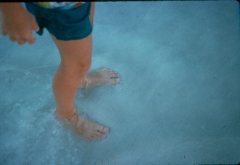
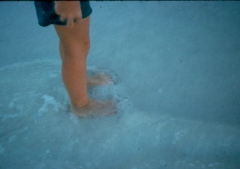
It is easy to understand thixotropy. Begin Next, wiggle your toes and note that
by standing still on the sand. "sinking feeling."
Photo by Bob Thomas. Photo by Bob Thomas.
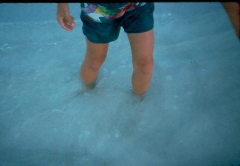
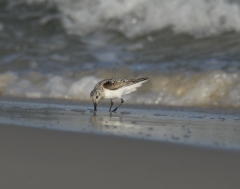
Ahhh. Success! Sanderling, Calidris alba, feeding in
Photo by Bob Thomas. the swash zone. Using thixotropy, they use
a machine-gun style of probing for
food, often to the base of the beak.
Photo by Shannon Fortenberry.
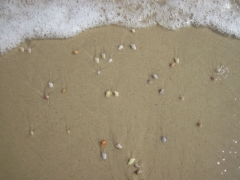
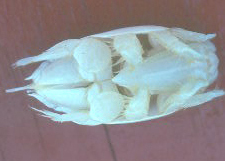
Coquinas, Donax variabilis, take advantage Mole crab, Emerita portoricensis, venter.
of thixotropy to disappear rapidly after being In order to stimulate the sand, the mole
exposed by an incoming wave. crab uses its telson, the pointed structure
Photo by Bob Thomas. pointing to the left.
Photo by Bob Thomas.